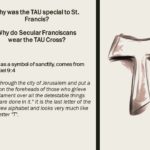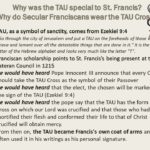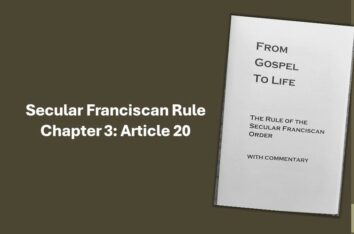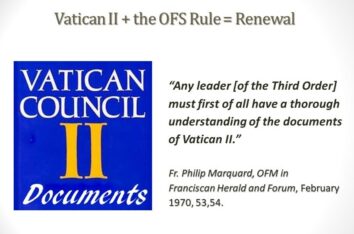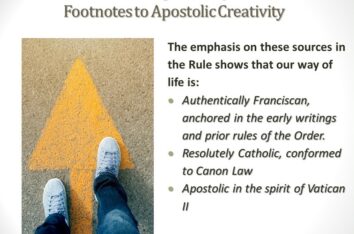Please share with your local fraternities (abajo en español)
We are all part of a history and a story. We are part of a “tribe.” We are part of the story of our families, of our religion, of the time in which we live. As Franciscans we are also part of the Franciscan story. There are traditions, stories, devotions, prayers and sayings involved with all of these groups. Knowing about them helps us to be part of the family. Every so often, Formation Friday will highlight one of these important parts of our story.
Why was the TAU special to St. Francis? Why do Secular Franciscans wear the TAU?
The TAU Cross
· TAU, as a symbol of sanctity, comes from Ezekiel 9:4
“Go through the city of Jerusalem and put a TAU on the foreheads of those who grieve and lament over all the detestable things that are done in it.” It is the last letter of the Hebrew alphabet and looks very much like the letter “T”.
· Franciscan scholarship points to St. Francis’s being present at the Lateran Council in 1215
· He would have heard Pope Innocent III announce that every Catholic should take the TAU Cross as the symbol of their Passover
· He would have heard that the elect, the chosen will be marked with the sign of the TAU (Ezekiel 9:4)
· He would have heard the pope say that the TAU has the form as the Cross on which our Lord was crucified and that those who had mortified their flesh and conformed their life to that of Christ crucified will obtain mercy.
· From then on, the TAU became Francis’s own coat of arms and he often used it in his
writings as his personal signature.
St. Bonaventure said, “This TAU symbol had all the veneration and all the devotion of the saint: he spoke of it often in order to recommend it, and he traced it on himself before beginning each of his actions.”
Thomas of Celano, another Franciscan historian and biographer of Francis, writes, “Francis preferred the Tau above all other symbols: he utilized it as his only signature for his letters, and he painted the image of it on the walls of all the places in which he stayed.”
In the famous blessing of Brother Leo, Francis wrote on parchment,
“May the Lord bless you and keep you! May the Lord show His
face to you and be merciful to you! May the Lord lift up His
countenance upon you and give you peace! God bless you Brother
Leo!” Francis sketched a head (of Brother Leo) and then drew the TAU over this portrait.
Due, no doubt, in large part to Francis’ own affection for and devotion to the TAU, it has been a well-recognized and accepted Franciscan symbol among Franciscans of various denominations and of all orders within those denominations for centuries. It remains so today. The TAU carries with it all of the symbolism of the Cross of Christ as well as Francis’ ideal of life and dream for himself and his followers.
The TAU is the designated as the distinctive sign of the Secular Franciscan Order of
the United States.
Secular Franciscans, do you wear your TAU every day? What do you think about when you put on your TAU?
(Information from the FUN Manual)
Todos somos parte de una historia y una historia. Somos parte de una “tribu”. Somos parte de la historia de nuestras familias, de nuestra religión, del tiempo en que vivimos. Como franciscanos, también somos parte de la historia franciscana. Hay tradiciones, historias, devociones, oraciones y dichos relacionados con todos estos grupos. Saber sobre ellos nos ayuda a ser parte de la familia. De vez en cuando, el Viernes de Formación destacará una de estas partes importantes de nuestra historia.
¿Por qué la TAU fue especial para San Francisco? ¿Por qué usan la TAU los franciscanos seglares?
La cruz TAU
• La TAU, como símbolo de santidad, proviene de Ezequiel 9: 4
“Pase por la ciudad de Jerusalén y ponga un TAU en la frente de aquellos que lloran y lamentan todas las cosas detestables que se hacen en él”. Es la última letra del alfabeto hebreo y se parece mucho a la letra “T”.
• La erudición franciscana apunta a la presencia de San Francisco en el Concilio de Letrán en 1215.
• Habría escuchado al Papa Inocencio III anunciar que todo católico debería tomar la Cruz TAU como símbolo de su Pascua.
• Habría escuchado que los elegidos, los escogidos serían marcados con el signo de la TAU (Ezequiel 9: 4)
• Habría escuchado al Papa decir que la TAU tiene la forma de la Cruz en la cual nuestro Señor fue crucificado y que aquellos que mortifiquen su carne y conformen su vida a la de Cristo crucificado obtendrán misericordia.
• A partir de entonces, la TAU se convirtió en el escudo de armas de Francisco y él lo usó a menudo en sus
escritos como su firma personal.
San Buenaventura dijo: “Este símbolo TAU tenía toda la veneración y la devoción del santo: hablaba de él a menudo para recomendarlo, y lo trazó sobre sí mismo antes de comenzar cada una de sus acciones.”
Tomás de Celano, otro historiador franciscano y biógrafo de Francisco, escribe: “Francisco prefería el Tau sobre todos los demás símbolos: lo utilizaba como su única firma para sus cartas, y pintaba la imagen en las paredes de todos los lugares en que se quedó “.
En la famosa bendición del hermano Leo, Francisco escribió en pergamino:
“El Señor te bendiga y te guarde;
t e muestre su faz y tenga misericordia de ti.
Vuelva a ti su rostro y te conceda la paz.
El Señor te bendiga, hermano León.”
Francisco dibujó la cabeza (del hermano León) y luego dibujó la TAU sobre este retrato.
Debido, sin duda, en gran parte al afecto y la devoción de Francisco por la TAU, ha sido un símbolo franciscano bien reconocido y aceptado entre los franciscanos de varias denominaciones y de todas las órdenes dentro de esas denominaciones durante siglos. Sigue siendo así hoy. La TAU lleva consigo todo el simbolismo de la Cruz de Cristo, así como el ideal de vida y sueño de Francisco para él mismo y sus seguidores.
La TAU es designada como el signo distintivo de la Orden Franciscana Seglar de los Estados Unidos.
Hermanos y hermanas franciscanos seglares, ¿Usas tu TAU todos los días? ¿En qué piensas cuando te pones la TAU?
Información de la Manual FUN
